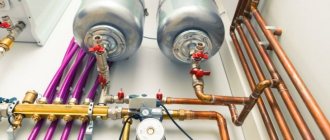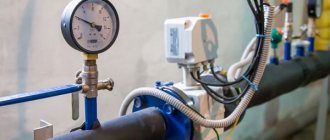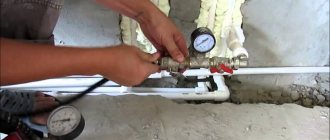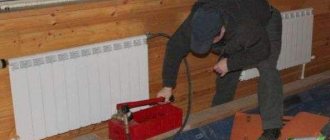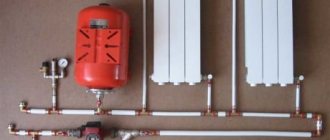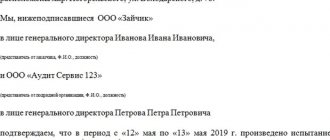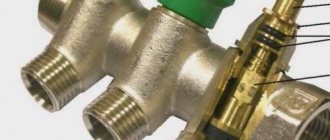WFP 2018/2019
Hydraulic testing is a type of non-destructive testing of equipment strength/density. It is carried out by creating excess pressure with water.
The frequency of hydraulic testing for heating installations and heating networks is 1 year.
The following are subjected to hydraulic tests for thermal energy consumers:
- heating network
- heating points
- heating systems
- heat supply systems for heaters and heaters themselves
- DHW/heating heat exchangers
Hydraulic testing of heating networks
In cases where the heat supply to the facility is carried out from the heating networks of RUE Minskenergo or UE Minskkomunteploseti, the acts are issued by the above-mentioned organizations.
Pay attention to filling out the report; the characteristics of the heating networks (length, diameter, connection point) specified in the hydraulic test report must correspond to the networks on the consumer’s balance sheet in accordance with the act of delimiting the balance sheet ownership of heating networks
Example of a completed hydraulic test report for a heating network:
Hydraulic testing of internal heat consumption systems
Heat exchangers, whether DHW or heating systems, must be pressure tested with the pressure specified in the passport, but not lower than 1 MPa. They are often tested at 12.5 ata or 16 ata.
The heating system is tested to a pressure of 1.25 working pressure but not lower than 0.6 MPa (6 atm) for heating systems with cast iron heating devices. Heating systems with panel and convector heating are tested at 1 MPa (10 ata).
Preparing for the heating season
Hydrotesting of heat supply lines is an important factor for their uninterrupted operation. Over time, all elements of these engineering structures wear out and can fail at the most inopportune moment. To prevent this from happening, two important measures need to be taken before the start of the heating season.
More information on how to perform hydraulic tests of heating systems:
Hydraulic tests
Each building heating system has a certain operating pressure. It is this parameter that determines the level of heating of the premises, the quality of fluid circulation, as well as heat losses. The choice of the main operating pressure indicator is influenced by various factors - the type of building, its number of floors, the quality of the pipeline, etc.
Testing the heating system is needed to measure pressure and determine the level of heatingAs the coolant moves through the pipes, a large number of different hydraulic processes occur. As a result, pressure drops are observed throughout the entire system, called water hammer. Due to these loads, the service life of all elements of the heating system is reduced. Thus, tests must be carried out at a pressure 1.2−1.4 times higher than the nominal value.
To carry out pressure testing, you must first fill the system with water. Then you need to raise the pressure to the calculated value, monitoring the process using a pressure gauge. After completing these steps, the system should remain pressurized for 30 minutes. If during this period of time it did not fall and there were no leaks in the system elements, then the test is considered passed.
It should be noted that in some situations a pressure drop of up to 0.1 atmosphere is allowed. In this case, a visual inspection should not reveal leaks, as well as violations of the tightness of threaded and welded connections. If the system fails the test, repair work is required. After their completion, crimping is performed again.
Testing your heating system can help identify leaks.
Types of actions during crimping
Based on this, such a procedure could be:
- Pneumopressing. The main goal of this method is to check the tightness of both individual connections and the entire system as a whole. For its implementation, electric and also manual pneumatic pumps are used, which make it possible to fill all elements with compressed air. In this case, it is necessary to maintain the required level of conditioning within the system in order to obtain accurate results.
Expert Advice: Carrying out a pneumatic inspection of a heating system is very dangerous. The fact is that if there are defects, air will quickly be released through them, which can cause great damage. That is why the pressure should not be increased above 0.15 MPa.
- Hydropressing. Such a study is also carried out to check the strength of the system. To create the required pressure, conventional hydraulic pumps of suitable power are used. Typically, to carry out such pressure testing, the pressure in the heating main is higher than the standard working pressure by an average of 30%, while during an air test this figure is 50% higher than the permissible value.
Hydropneumatic flushing of heating systems
This washing method is considered universal and inexpensive and is therefore used quite often. Its implementation will require a large amount of water.
When connecting a house to a central heating main, the coolant coming from it is usually used. If the heating system is autonomous, then the structural elements are washed with cold water (more details: “Hydropneumatic flushing and hydroflushing of heating systems”). The sequence of actions is as follows:
- the system is reset - initially from the supply to the return, and then in the opposite direction;
- a stream of compressed air supplied by a compressor is mixed into the coolant flow through the valve. The resulting pulp cleans the internal surfaces of silt and partially of sediments;
- if there are risers, they are washed in groups in turn so that the pulp flow covers no more than 10 objects. It is better if the number of risers in the group is less. Washing is carried out until the pulp sent for discharge becomes transparent.
When cleaning the heating system yourself, it is advisable to wash the risers one at a time, then not only the liner will be washed, but also the radiator itself.
Additional work
After washing pipes and other equipment, it is advisable to perform pressure testing. This additional procedure will allow you to check the tightness of the entire system and identify places where air or water may escape. Such actions are not mandatory, but highly desirable. They correspond to the interests of both the customer and the contractor. Upon completion, both will be able to verify the quality of the previous stage. The execution of work records the act of washing and its sample will look like a table that contains a list of all activities carried out during such a procedure.
Against each of the points, the specialist must make a note of completion. At the end, as usual, the customer and the contractor put their signatures, confirming the fact of the work. Experts sometimes call this procedure a hydraulic test, since most often such a test is carried out using water. It is believed that the air may be more dangerous when serious faults are detected. Therefore, many people prefer to take the easier path.
Certificate of pneumatic testing of pipelines
Pneumatic method: diagnosis by pumping the system with high pressure air. Often the method is used for external systems if the temperature on the thermometer is less than +5 Celsius.
The procedure for crimping pipes by pneumatic testing is given in the same SanPiN; the test report is drawn up in the required form, which is given in Appendix No. 3.
Requirements for drawing up test documentation:
- Filling in the name of the city and the date of compilation.
- Indication of the members of the commission (as in the hydraulic test, three parties are involved).
- Description of the pipeline: length, diameter, material of pipes and joints.
- Information about the pressure value: calculated value, to what value the pressure in the pipes was increased, final pressure, amount of reduction. The crimping time is indicated.
- In the “Decision of the Commission” section, each of its members signs with a transcript if the pipeline has passed pneumatic diagnostics and is sealed and durable.
The procedure for organizing cleanup work
The coolant in pipes is water, which contains various contaminants that settle and compact on the walls of the pipelines. They interfere with the normal circulation and functioning of the coolant, causing blockage of pipes and heating radiators.
The washing organization must:
- pre-inspect the equipment;
- draw up an act for hidden operations;
- select cleaning technology;
- draw up an estimate for flushing the heating system and a contract;
- perform work;
- carry out secondary pressure testing of the equipment;
- fill out the act form.
The act of flushing the heating system is an important document certifying the completion of work for specialized organizations providing such services.
The process of crimping heating pipes.
Pressure testing of equipment is performed with water or air. She must certify that the work was completed correctly.
One of the methods for assessing the technical condition of equipment is pressure testing, which reveals all faults before work begins. The pressure must be greater than the standard one, but not less than 2 atmospheres.
To check with air, a pump and a special pressure gauge are used, which measures the pressure in the system. If the pressure does not change, then the equipment is sealed, and if it decreases, you need to look for the place where the leak occurs and fix the problem.
An act is drawn up for various hidden operations: dismantling radiators, disconnecting flanges, preparatory work. Next, a cleaning technology is selected, but in most cases the hydropneumatic method is used.
The estimate for flushing the heating system includes the price of fuel, equipment depreciation, and reagents.
Then an agreement is drawn up, which stipulates the main points of cooperation:
- service cost;
- calculation procedure;
- deadlines;
- the amount of fines in case of failure to fulfill obligations;
- obligations and responsibilities of the parties;
- procedure for terminating the contract.
After cleaning is completed, secondary pressure testing is carried out and the functionality of the equipment is checked. A washing report form is filled out, where the customer evaluates the quality of the service.
The document is completed immediately after completion of the work. If the terms of the contract are not fulfilled and the quality of the service does not satisfy the customer, the document is not signed until all defects and malfunctions are eliminated.
Chemical flushing of heating systems
In the process of chemical cleaning of elements of heating structures, the circuit is filled with reagents (an acid or alkali solution with inhibitors to prevent corrosion processes in pipelines) and their long-term circulation in the system is ensured (for more details: “Flushing a heating system in a private house - instructions and rules for flushing”).
Used compounds are disposed of, but since they are not allowed to be drained into the sewer (reagents can significantly shorten its service life), neutralization is first carried out by adding an alkaline solution to the acidic reagents and vice versa.
Purpose of testing
Tests must be carried out after the creation of a new network or after major repairs, preventive maintenance and reconstruction of an existing one, and also before the start of the heating season.
After which new testing is carried out, and this continues until results that correspond to the norm are obtained. Actually, there are two stages of testing: preliminary and final.
Please note: pressure testing is carried out to check tightness and integrity, as well as to detect possible defects in any section of the water supply system, including boilers.
Such checks are the most popular pressure testing process for heating systems. This happens by simulating water hammer, when pressure is pumped into the system several times higher than the standard one.
Specialist's note: all defects and deficiencies discovered during the pressure testing must be eliminated immediately and without delay.
In what cases is it compiled?
The act is required when:
- Commissioning of new equipment. The certificate will confirm that each element is in its place, the installation was carried out responsibly, and the system is working.
- The heating season is approaching. After a summer break in work, the pipes could fail. After checking their capacity, a report is drawn up.
- Already carried out repair work.
- The occurrence of contained emergency situations on the pipeline. In this way, specialists identify the amount of work required and the weak points of the existing heating network.
For the uninterrupted operation of the heating system, preventative control checks and reliable information about the quality functioning of the system upon startup are necessary.
The procedure for organizing cleanup work
The coolant in pipes is water, which contains various contaminants that settle and compact on the walls of the pipelines. They interfere with the normal circulation and functioning of the coolant, causing blockage of pipes and heating radiators.
The washing organization must:
- pre-inspect the equipment;
- draw up an act for hidden operations;
- select cleaning technology;
- draw up an estimate for flushing the heating system and a contract;
- perform work;
- carry out secondary pressure testing of the equipment;
- fill out the act form.
The act of flushing the heating system is an important document certifying the completion of work for specialized organizations providing such services.
The process of crimping heating pipes.
Pressure testing of equipment is performed with water or air. She must certify that the work was completed correctly.
One of the methods for assessing the technical condition of equipment is pressure testing, which reveals all faults before work begins. The pressure must be greater than the standard one, but not less than 2 atmospheres.
To check with air, a pump and a special pressure gauge are used, which measures the pressure in the system. If the pressure does not change, then the equipment is sealed, and if it decreases, you need to look for the place where the leak occurs and fix the problem.
An act is drawn up for various hidden operations: dismantling radiators, disconnecting flanges, preparatory work. Next, a cleaning technology is selected, but in most cases the hydropneumatic method is used.
The estimate for flushing the heating system includes the price of fuel, equipment depreciation, and reagents.
Then an agreement is drawn up, which stipulates the main points of cooperation:
- service cost;
- calculation procedure;
- deadlines;
- the amount of fines in case of failure to fulfill obligations;
- obligations and responsibilities of the parties;
- procedure for terminating the contract.
After cleaning is completed, secondary pressure testing is carried out and the functionality of the equipment is checked. A washing report form is filled out, where the customer evaluates the quality of the service.
The document is completed immediately after completion of the work. If the terms of the contract are not fulfilled and the quality of the service does not satisfy the customer, the document is not signed until all defects and malfunctions are eliminated.
Algorithm for completing documents and the procedure for drawing up an act
Organizations involved in the repair and maintenance of heating systems have an algorithm for drawing up documents and a procedure for drawing up reports that determine the procedure for flushing.
Such instructions are usually composed as follows:
- Inspection of heating equipment for cracks, chips and places where the walls of the pipeline have become thin. The pipeline is checked using increased pressure, the value of which increases by 1.25 times. Moreover, its value should not be less than 2 atmospheres. Such a check is carried out to ensure that the detected malfunction (if any) does not become a cause of disagreement between the customer and the contractor;
- After inspection, repair work is carried out to eliminate cracks, leaks, etc.
- The next step is to draw up an act containing information about the previous stage. That is, records are made about unforeseen repairs;
- After documenting the repair, a method for flushing the heating system in your home is selected. Most often, hydropneumatic washing is chosen, which is carried out using a pulp containing water and compressed air;
- The penultimate step is drawing up an estimate of the work done, the cost of which includes the cost of depreciation of equipment, fuel costs, chemicals, and also takes into account the labor of workers.
Based on all of the above, a contract for flushing the heating system is drawn up. This document, the act, stipulates the cost of services provided and the sequence of their implementation. In particular, the contract and form stipulate the responsibilities and obligations of the customer and the contractor and the timing of flushing the heating system
It is very important to include in the contract fines and sanctions for failure to complete it on time or for poor performance.
Sample contract
These points will help avoid conflicts and push the contractor to perform higher quality and more conscientious work.
This clause is called “liability of the parties”. It is also necessary to indicate in the act for flushing the heating system in what cases, in what situation and for what reasons this contract can be terminated
At this stage, the work is just beginning, since before flushing the heating it is necessary to carefully check everything and document both the test results and organizational issues. The drawn up agreement is signed by the parties. It must be remembered that all controversial issues that arise and are not resolved at the level of management of the organization carrying out the work are resolved in court. To do this, it is extremely important to keep all documents confirming the work carried out by company representatives in your home.
The final stage is the actual work of flushing the heating system; then a secondary check of the pipeline and radiators should be carried out for leaks and cracks. Then a final performance check is carried out and, after the customer evaluates the work, the heating in the house is started.
Important test details
In this case, the checks themselves can be carried out in one of two ways:
- manometric;
- hydrostatic.
The first testing method involves the use of pressure gauges that record and demonstrate the pressure in the system.
Please note: using pressure gauges, the amount of excess pressure is determined, which allows us to draw a conclusion about the reliability of the test.
The second method checks the real readiness of the system for operation by checking its performance at a pressure 50% higher than the standard. Any test lasts at least 10 minutes, the permissible pressure drop during pressure testing is no more than 0.02 MPa.
Good to know: the main document evidencing the conduct of tests is the corresponding act.
Hydraulic test procedure
The procedure and rules for conducting hydraulic testing of the heating system are regulated by the following regulatory documents:
- SNiP 41-01-2003 “Heating, ventilation and air conditioning”;
- SNiP 3.05.01-85 “Internal sanitary systems”;
- Rules for the technical operation of thermal power plants, developed by the Ministry of Fuel and Energy of the Russian Federation, approved in 2003.
The procedure for hydropressing
The process of testing a heating system for leaks can be simplified into the following tasks:
- visual inspection of all elements, incl. equipment, risers, highways, existing connections;
- flushing the system from various types of contaminants and deposits;
- filling the circuit with water with mandatory bleeding;
- connecting the compressor and increasing the pressure;
- identification of faults and their repair or conclusion about the operability and readiness of the system for operation (if during the inspection it was necessary to perform any repair work, the process should be repeated);
- drawing up a report on the tests performed.
Business and finance
BanksWealth and welfareCorruption (Crime)MarketingManagementInvestmentSecuritiesManagementOpen joint-stock companiesProjectsDocumentsSecurities - controlSecurities - assessmentsBondsDebtCurrencyReal estate (Rent)ProfessionsWorkTradeServicesFinanceInsuranceBudgetFinancial servicesCreditsCompaniesState-owned enterprisesEconomyMacroeconomicsMicro EconomicsTaxesAuditMetallurgyOilAgricultureEnergyArchitectureInteriorFloors and ceilingsConstruction processBuilding materialsThermal insulationExteriorOrganization and production management
Test report for ladders, racks and stepladders
Inspection and testing of racks, ladders and stepladders is carried out at least once every six or twelve months (depending on the object being tested and the material from which it is made).
Tests and checks for safe operation can be carried out by specialized organizations from outside or a commission specially created at the enterprise. At the same time, its members must be trained; an occupational safety or fire safety engineer is usually appointed as the chairman of the commission.
As a result of the diagnosis, the commission draws up a report; it is better to document it with the date of the inspection. The header indicates the name of the document, date and place of compilation. It is also important to indicate the details of the organization, list the members of the commission: their positions and full names.
In the main part, describe the tests of stepladders, ladders and racks:
- how many were checked, their inventory numbers, belonging to the workshop and department;
- what load was used and for how long;
- presence and absence of defects;
- availability of an assigned inventory number.
Stages of implementation
This procedure is carried out in stages:
- First, all connections are checked, as well as the functionality of the locking elements. Their condition is visually assessed.
- After this, not only the boiler, but even the expansion tank is disconnected from the system. This is necessary to completely flush the pipeline and radiators from the possible presence of small debris in them.
- Next, the crimping itself begins. To do this, water is poured into the system from the water supply and a compressor is connected to the drain valve and the pressure is gradually increased until it reaches the desired value. If there are no downward changes in the indicators, this indicates that the system is completely sealed and can be put into operation. If there is a hole in the thermal pipe assembly, there will be a sharp drop in pressure in the system.
Please note: the average time for hydropress testing is one hour, while 20 minutes is enough for a pneumatic test.
- If malfunctions are found, they are eliminated and the procedure is repeated.
- When the system has confirmed its tightness based on the test results, a pressure test report is drawn up.
Please note: you cannot carry out such a procedure alone, because such a process requires special skills and knowledge
It is important to correctly follow all safety measures.
How to do it right: the act of crimping a heating main
The operation to monitor the integrity of the entire heating main line is called pressure testing. The operation is usually carried out on a relatively small section of the pipeline. This section is isolated from the main line, subjected to tests using increased pressure not exceeding permissible limits.
The system is considered suitable for use if it remains sealed during testing. But if the system is broken and a weak point is found, then the entire section of the faulty pipe must be repaired. Pressure testing is necessary to test all new water lines and old systems.
How to do crimping:
Cover and seal the area that will be repaired. Close the supporting fittings (shut off all valves and taps)
It is important to do this at both ends of the site. Connect a source that creates the required pressure. To do this, use a special pressure test pump or a conventional pump responsible for circulating coolant in the system. For crimping, special taps are used, attached to each radiator. It is possible to pressurize the water supply through the pipe where both hot and cold water are connected. Many test indicators depend on how durable the pump is
A pump with low power will increase the test time. A weak crimper will not be able to quickly cope with filling the dimensional pipe with the required air volume. Leaky joints can change the results for the worse
Many inspection parameters depend on how durable the pump is. A pump with low power will increase the test time. A weak crimper will not be able to quickly cope with filling the dimensional pipe with the required air volume. Leaky joints can change the results not for the better.
Tips and tricks
When purchasing heating radiators, it should be taken into account that bimetallic and aluminum heat exchangers have a small volume in which the circulating coolant does not form sediment.
When choosing a heating system, preference should be given to closed types. Such systems are characterized by a constant volume of coolant, which does not allow new deposits to form.
It is best to make the connection at the bottom of the radiator. Since sediment forms in horizontal areas, such a connection helps remove the bulk of the deposits with the flow of the working medium.
It is recommended to install a filter, which does not require large investments, but greatly simplifies the cleaning process. Removing scale from a dirt filter is easier than flushing the riser.
Roof fencing test report
Technical requirements and roof testing methods are enshrined in the same GOST as the standard for fire escapes and stepladders (53254-2009).
Tests are carried out at intervals of five years, integrity checks are carried out every year. The results are documented in acts.
The conditionally completed act can be divided into three parts:
- General information. Information about the tested object and the inspecting organization is entered here.
- Information about the inspection (what manipulations were carried out, what tools were used).
- Test results (compliance with GOSTs, integrity and safety of the structure).
The agreement of the commission members during testing is confirmed by their personal signatures.
Organizations with a license from the Ministry of Emergency Situations have the right to conduct inspections and tests. Defects found must be corrected.
The concept of crimping and timing
Pressure testing means a set of test measures to assess the tightness of the heating system.
Similar tests are carried out in the following cases:
- After assembling a new heating system before putting it into operation. In this case, the act is a permitting document for starting to use the networks.
- On previously installed and operating networks, hydraulic tests are carried out before the start of the heating season or immediately after completion.
- If preventive or repair work was carried out on the heating main, then hydrotesting is carried out upon completion.
- Mandatory pressure testing is carried out before replacing individual elements and equipment of the system, repairing radiators or pipelines. In this case, the measures taken make it possible to identify weak points in the system, which allows them to be replaced or repaired in a timely manner without waiting for an accident.
To carry out hydrotests, water or air is injected into the network under pressure. For this, a hydraulic or pneumatic pump is used. As a result, it is easy to identify areas and places with broken tightness of components and connections. If air is used, a characteristic whistle will be heard, and when pumping under water pressure, leaks will be detected. We can say that during hydrotesting, situations are artificially created that arise during water hammer, or during a critical increase in pressure in the line.
If the circuit elements and devices have a sufficient margin of safety, then increasing the pressure for half an hour will not harm them and will not affect their service life. But during this period of time at high pressure, weak areas, depressurized components and connections can be easily identified.
If the apartment has an autonomous heating system, it is recommended to periodically check it using a compressor. Such pneumatic pressure testing will protect against flooding of the lower floors while reducing the safety margin of the system.
Tasks of pressure testing a heating boiler
In total, we consider 3 determining reasons why heating boilers are pressure tested. In each of these cases, the event is carried out without fail, ensuring the safety of using the equipment by eliminating the likelihood of leaks of hot coolant.
Initial check
This type of pressure testing is carried out based on the results of installation work; it controls the integrity of the new heating system before putting it into operation. It is important to note that this procedure is carried out immediately after completion of the assembly work, and only then the pipeline is hidden in the planes of the walls or floor.
After the pipes have fallen under plaster or screed (primary types of finishing work), re-testing can be carried out. This will allow you to use expensive finishing materials intended for cosmetic finishing without risk.
Scheduled (periodic) inspection
This check is carried out annually at the end of the heating season. During this test, they inspect and identify weak points in the boiler circuit, as well as the piping system, preparing the equipment for the next season.
If the circuit under test pressure maintains the specified mark for the regulated time, then the system has passed the test. Otherwise, it is necessary to look for a leak and carry out repair work.
Emergency (extraordinary) inspection
If problems or leaks are detected in the heating system, repair work is carried out. To do this, it is necessary to drain the coolant, carry out a thorough flush, make sure that there are no salts in the cavities, and replace damaged areas. Before starting, after carrying out repair work, emergency pressure testing is carried out each time. This event checks the circuit for leaks.
Delivery of documents
Here
After completion of the work, a pressure testing certificate is drawn up, which has legal force.
This kind of document will confirm that:
- the heating system was checked for leaks in accordance with all standards;
- all equipment is in good condition and therefore ready for use;
- if after the issuance of such a document accidents occur, then all responsibility will fall on those who carried out the inspection.
Those responsible for carrying out this procedure, as well as its results, can be appointed:
- Representatives of the organization that provides heat supply (this is a foreman, inspector, or even an engineer and technician). They must have with them all the relevant documents, equipment, as well as forms of issued acts.
- Representatives of the facility itself where the pressure testing was carried out. Thus, in apartment buildings these are employees of management organizations, in private houses - their owners, and if the procedure is carried out in administrative or social facilities - these can be managers, as well as employees of supervisory organizations.
- In cases where pressure testing was done in a new building that is just being put into operation, representatives of the contractor should be added to the commission.
The water supply system is also checked in the same way. When all the taps in it are closed, increase the pressure to the required level and look for holes. All commercial properties are inspected exclusively on a paid basis, due to which the cost of work is always included in the estimate. Therefore, you need to find out in advance how much such a procedure will cost.
Watch the video in which a specialist explains in detail what pressure testing of a heating system is, why it is performed and where it is carried out:
Rules for filling out the Act
The heat supply organization is responsible for filling out the pressure test report.
A cap
- filling out the header of the Act begins with indicating the exact name of the thermal system being tested (this information is contained in its working documentation, project);
- The full name of the object served by the thermal installation is entered. It can be found in the building permit or in its design and estimate documentation;
- information about the locality, the date of testing/approval of the Act is entered (if no defects are identified and the documentation is completed on the day of the test activities).
Composition of the commission
The details of all members of the selection committee are indicated. It includes representatives of the general contractor, the customer and the organization that carried out the work. The representative of each party must provide information about the name of his organization, the position he holds in it, as well as his last name and initials.
